The Tabernacle Prayer Guide offers a biblical framework for deepening prayer life, inspired by the ancient Tabernacle’s structure and symbolism, connecting believers to God’s presence and purpose.
What is the Tabernacle?
The Tabernacle, a portable place of worship, was constructed by Moses according to God’s detailed instructions. It served as the dwelling place of God’s presence among the Israelites, symbolizing His divine connection with His people. Built with specific furnishings and rituals, the Tabernacle represented a sacred space where God met with humanity. Its structure, from the outer courtyard to the innermost holy place, reflected a progression toward intimacy with God. The Tabernacle’s design and purpose were deeply symbolic, pointing to Jesus Christ as the ultimate fulfillment of its sacrifices and rituals. It stands as a powerful model for prayer, teaching believers how to approach God with reverence, sacrifice, and a heart of worship.
The Significance of the Tabernacle in Prayer
The Tabernacle holds profound significance in prayer as it symbolizes God’s desire to dwell among His people and connect with them intimately. Its structure and furnishings serve as a visual representation of the steps to approach God, emphasizing sacrifice, cleansing, and communion. The Tabernacle teaches believers to enter prayer with reverence, acknowledging God’s holiness and their need for purification. It highlights the importance of intercession and fellowship, mirroring the relationship between God and His people. By studying the Tabernacle, prayers gain depth, structure, and a deeper understanding of God’s nature, making it a powerful guide for meaningful and effective prayer.
How the Tabernacle Serves as a Prayer Guide
The Tabernacle serves as a prayer guide by offering a structured approach to communion with God, reflecting the steps to His presence. Starting from the courtyard, it teaches the importance of sacrifice and repentance. The bronze laver symbolizes cleansing, reminding believers to purify their hearts before God. The altar of incense represents intercession, while the Ark of the Covenant signifies God’s mercy and presence. Each element guides prayers through atonement, purification, and fellowship, creating a holistic framework for meaningful dialogue with God. This sacred structure provides a model for prayers to approach God reverently, ensuring each aspect of prayer aligns with His divine order and purpose.
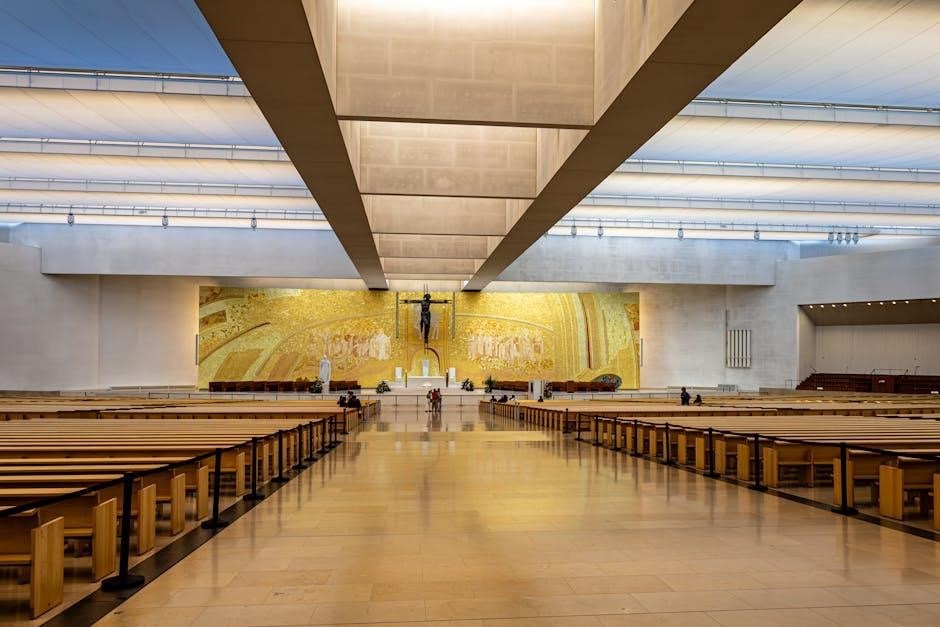
Historical and Spiritual Significance of the Tabernacle
The Tabernacle, built as God’s earthly dwelling, symbolizes His presence among His people, serving as a sacred space for worship and sacrifice, reflecting divine covenant and spiritual connection.
The Tabernacle as the Dwelling Place of God
The Tabernacle was a sacred structure where God dwelled among the Israelites, symbolizing His divine presence and covenant. Built according to precise divine instructions, it served as a physical manifestation of God’s desire to reside with His people. The Tabernacle’s design, from the outer courtyard to the innermost Holy of Holies, reflected God’s holiness and humanity’s need for atonement. By establishing this earthly dwelling, God provided a tangible way for His people to connect with Him, through sacrifices, worship, and prayer. This sacred space became the heart of Israel’s spiritual life, fostering intimacy and reverence for God’s divine nature.
The Tabernacle as a Symbol of God’s Presence Among His People
The Tabernacle was a powerful symbol of God’s presence among the Israelites, representing His abiding with them as a covenant community. Its construction and furnishings, meticulously designed, signified divinenearness and provided a focal point for worship. The cloud by day and fire by night above the Tabernacle visibly demonstrated God’s constant presence. This sacred structure served as a reminder of God’s faithfulness and His desire to dwell among His people, fostering a deep sense of connection and reverence. Through the Tabernacle, God’s presence was both revealed and experienced, making it a central symbol of His enduring relationship with Israel.
The Connection Between the Tabernacle and Worship

The Tabernacle was central to the Israelites’ worship, serving as a sacred space where they expressed reverence and devotion to God. Its design and furnishings were meticulously crafted to facilitate worship, reflecting God’s holiness and humanity’s need for atonement. The outer courtyard, with the altar of sacrifice and bronze laver, symbolized the initial steps of worship—sacrifice and purification. The Holy Place, containing the table of showbread and golden lampstand, represented communion and the light of God’s presence. The Most Holy Place, housing the Ark of the Covenant, was the pinnacle of worship, where God’s presence dwelled. The Tabernacle’s structure and rituals provided a framework for worship, emphasizing God’s glory and humanity’s awe-inspired response. Through the Tabernacle, worship became an act of surrender, gratitude, and intimacy with the Divine.

The Structure of the Tabernacle
The Tabernacle was a portable place of worship, carefully designed according to God’s instructions, with a clear division into the courtyard, Holy Place, and Most Holy Place. Each section symbolized a step closer to God’s presence, emphasizing reverence and purification. The courtyard, with its altar and laver, represented sacrifice and cleansing. The Holy Place contained the table of showbread, lampstand, and altar of incense, focusing on communion, light, and prayer. The Most Holy Place held the Ark of the Covenant, the seat of God’s mercy. This structure not only facilitated worship but also served as a visual guide for prayer, teaching believers how to approach God with reverence and intimacy. Its design reflected the necessity of purification, sacrifice, and devotion in worship, offering a profound model for prayer today.
Overview of the Tabernacle’s Layout
The Tabernacle was a portable structure designed for worship, divided into three main sections: the Courtyard, the Holy Place, and the Most Holy Place. The Courtyard, accessible to all Israelites, contained the Altar of Sacrifice and the Bronze Laver, symbolizing atonement and purification. The Holy Place, reserved for priests, housed the Table of Showbread, the Golden Lampstand, and the Altar of Incense, representing communion, divine light, and prayer. The Most Holy Place, the innermost sanctum, held the Ark of the Covenant, the seat of God’s presence. This layout emphasized progressive closeness to God, teaching believers to approach Him with reverence, preparation, and intimacy. The design reflected a journey from sacrifice to communion, mirroring the prayer journey of believers today.
The Courtyard: The Outer Chamber of Worship
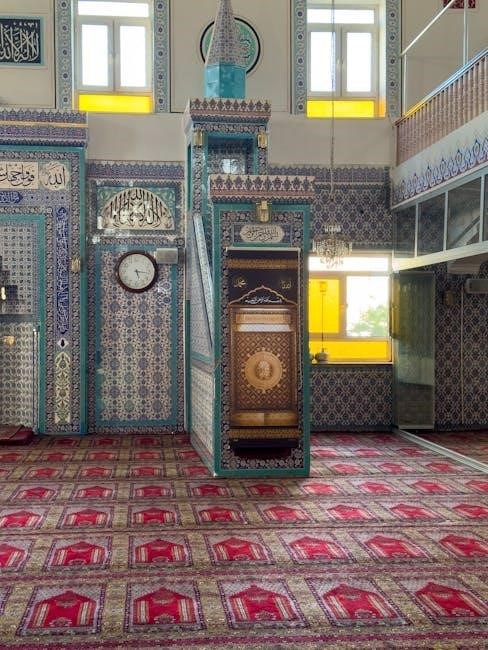
The Courtyard, as the outer chamber of worship, served as the Israelites’ initial point of contact with God. It housed the Altar of Sacrifice and the Bronze Laver, symbols of atonement and purification. This space emphasized the importance of approaching God with reverence, through sacrifice and cleansing. For modern prayer, the Courtyard teaches the value of beginning with confession and purification, preparing the heart for deeper communion. It represents the foundational steps in our spiritual journey, mirroring the initial approach to God in prayer.
The Holy Place: The Inner Sanctuary
The Holy Place, the inner sanctuary of the Tabernacle, symbolized a deeper level of intimacy with God. It contained the Table of Showbread, the Golden Lampstand, and the Altar of Incense, each holding profound spiritual significance. The Table of Showbread represented fellowship and communion with God, while the Golden Lampstand signified the light of God’s presence and revelation. The Altar of Incense stood as a symbol of prayer ascending to God, emphasizing the importance of intercession. This sacred space taught the Israelites—and modern believers—how to approach God with reverence and preparation, fostering a deeper relationship through prayer, light, and fellowship.
The Most Holy Place: The Throne Room of God
The Most Holy Place was the innermost sanctuary of the Tabernacle, housing the Ark of the Covenant, which symbolized God’s throne and mercy seat. This sacred space was accessible only to the high priest on the Day of Atonement, emphasizing its reverence and holiness. The Ark, adorned with cherubim, represented God’s divine presence and the seat of His mercy. In prayer, the Most Holy Place teaches believers to approach God with awe and reverence, recognizing His sovereignty and grace. It also points to Jesus Christ, who became the ultimate mercy seat through His sacrifice, granting believers direct access to God’s throne in prayer.
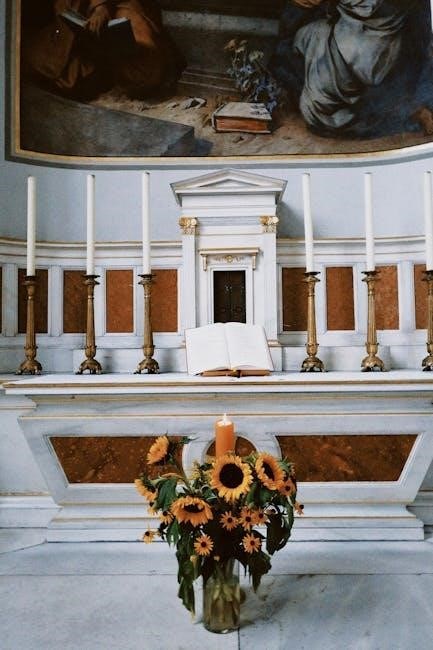
The Furnishings of the Tabernacle and Their Prayer Significance
The Tabernacle’s furnishings symbolize prayer’s deeper dimensions, from sacrifice and cleansing to communion, light, and intercession, guiding believers to encounter God’s presence and mercy.
The Altar of Sacrifice: A Symbol of Atonement
The Altar of Sacrifice, a central element of the Tabernacle, represents the atonement for sin through the shedding of blood. It signifies the ultimate sacrifice of Jesus Christ on the cross, where He paid the price for humanity’s redemption. In prayer, this altar reminds us of the necessity of acknowledging our sins and seeking forgiveness. It serves as a powerful symbol of God’s mercy and grace, encouraging believers to approach Him with humility and gratitude. The altar’s presence in the Tabernacle underscores the importance of sacrifice in prayer, teaching us to surrender our lives to God and trust in His divine plan.
The Bronze Laver: Representing Cleansing and Purification
The Bronze Laver, positioned between the Altar of Sacrifice and the Holy Place, symbolizes spiritual cleansing and purification. Priests washed their hands and feet here before entering the sanctuary, reflecting the need for moral purity in worship. In prayer, this element encourages believers to examine their hearts and seek cleansing from sin. It serves as a reminder of God’s holiness and the necessity of purity in approaching Him. The Bronze Laver teaches us to prepare our spiritual lives through confession and repentance, ensuring our prayers are offered with a clean and humble heart, aligning with God’s desire for intimacy and reverence.
The Table of Showbread: A Symbol of Communion and Fellowship
The Table of Showbread, placed in the Holy Place, held twelve loaves of unleavened bread, symbolizing God’s presence and provision. This sacred furniture represented fellowship and communion between God and His people. The bread, always present, signified God’s enduring faithfulness and desire for relationship. In prayer, the Table of Showbread teaches us to seek intimacy with God, maintaining a consistent and humble connection. It reminds us that prayer is not just a ritual but a deeper communion with the Father. The Showbread also reflects Jesus, the Bread of Life, who invites believers to partake in His divine fellowship, ensuring our prayers are rooted in gratitude and a longing for His presence.
The Golden Lampstand: Representing the Light of God’s Presence
The Golden Lampstand, crafted from pure gold, stood in the Holy Place, symbolizing the radiant light of God’s presence. Its seven branches, adorned with decorative cups, represented divine perfection and completeness. The priests were tasked with ensuring the lamps remained lit, using pure olive oil, signifying the need for constant vigilance and preparation in prayer. The Lampstand not only illuminated the sanctuary but also served as a reminder of God’s guidance and illumination in believers’ lives. In prayer, it teaches us to seek the Holy Spirit’s enlightenment and to walk in the light of God’s truth, reflecting Jesus, who is the Light of the World. This sacred object inspires believers to pursue a life of purity and consistent communion with God.
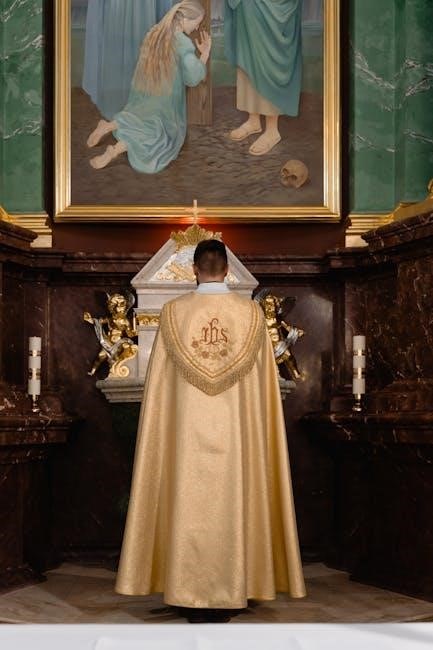
The Altar of Incense: A Symbol of Prayer and Intercession
The Altar of Incense, placed before the veil of the Most Holy Place, was a focal point for prayer and intercession. Priests offered incense daily, symbolizing the ascent of prayers to God. The fragrance of the incense represented the sweetness of sincere worship and intercession. This altar teaches believers to approach prayer with reverence and a heart of worship, understanding that our prayers rise to God like a pleasing aroma. It emphasizes the importance of interceding for others and maintaining a consistent prayer life, aligning our requests with God’s will. The Altar of Incense serves as a powerful reminder of the transformative power of prayer and its role in connecting humanity with the divine.
The Ark of the Covenant: The Seat of God’s Mercy and Presence
The Ark of the Covenant, housed in the Most Holy Place, was the earthly manifestation of God’s throne. It symbolized His divine presence and mercy, with the lid serving as the mercy seat. The Ark held the Ten Commandments, representing God’s covenant with His people. In prayer, the Ark reminds us of God’s faithfulness and the importance of seeking His mercy. It teaches believers to approach God with reverence, acknowledging His holiness and grace. The Ark also signifies the ultimate fulfillment of God’s presence through Jesus Christ, who became the true mercy seat for humanity. This symbol encourages believers to pray with awe and gratitude, trusting in God’s unfailing love and redemption.
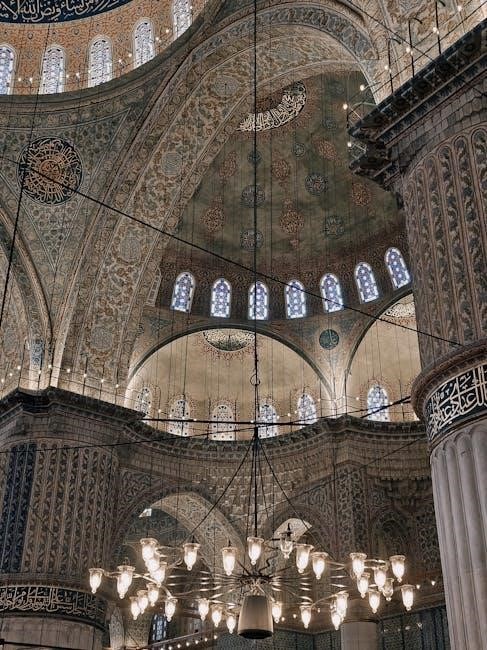
Prayer Lessons from the Tabernacle
The Tabernacle offers profound lessons for prayer, emphasizing sacrifice, cleansing, and fellowship with God. It teaches believers to approach prayer with reverence and intimacy, reflecting God’s presence in their lives through worship and intercession, while maintaining a consistent and meaningful dialogue with Him.
The Importance of Sacrifice in Prayer
The Tabernacle emphasizes sacrifice as a foundational element of prayer. The altar, representing the cross of Jesus Christ, symbolizes the ultimate sacrifice for humanity. This teaches believers to approach prayer with a spirit of surrender, offering their lives as living sacrifices. Sacrifice in prayer involves laying down personal desires and aligning one’s will with God’s purpose; It reflects humility, obedience, and a deep commitment to fellowship with God. The Tabernacle’s design underscores that prayer is not just a request but a sacred act of giving oneself to God. This principle transformative power in prayer, drawing believers closer to His presence and will. By embracing sacrifice, prayers become acts of worship and devotion, mirroring the Tabernacle’s sacred structure.
Cleansing and Preparation for Effective Prayer
The Tabernacle highlights the bronze laver, symbolizing cleansing and purification, as a prerequisite for effective prayer. Before entering the Holy Place, priests washed their hands and feet, reflecting the need for spiritual purity. This teaches believers to prepare their hearts through confession and repentance before praying. Cleansing is essential to align with God’s holiness and ensure prayers are unhindered. The laver reminds us that prayer requires humility, self-examination, and a willingness to let go of sin. By embracing this principle, believers can deepen their prayer life, fostering intimacy with God and ensuring their prayers are pleasing to Him. Preparation and cleansing are vital steps in drawing near to His presence.
Fellowshipping with God Through Prayer
The Tabernacle Prayer Guide emphasizes the Table of Showbread as a symbol of communion and fellowship with God. This table, always laden with fresh bread, represents God’s desire for intimate relationship and ongoing connection with His people. In prayer, this principle translates to a deep, personal communion with God, where believers engage in two-way dialogue rather than one-sided requests. Jesus, the “Bread of Life,” embodies this fellowship, inviting believers to partake in His presence. Through prayer, we experience intimacy, partnership, and joy in walking with God, reflecting the eternal communion He desires with His children. This fellowship enriches prayer, making it a vibrant, relational experience.
Walking in the Light of God’s Presence
The Tabernacle Prayer Guide highlights the Golden Lampstand as a symbol of God’s radiant presence and light in believers’ lives. This lampstand, placed in the Holy Place, was continually lit, representing the Holy Spirit’s illumination and guidance. In prayer, this teaches the importance of walking in God’s light, seeking His wisdom, and aligning prayers with His divine will. Just as the priests maintained the lampstand, believers are called to nurture their spiritual light through consistent prayer and fellowship with God. This practice ensures that prayers are not based on human understanding but on the divine light that guides and transforms hearts, leading to a deeper walk with God and a life that reflects His glory.
The Power of Intercession in Prayer
The Tabernacle Prayer Guide emphasizes the Altar of Incense as a powerful symbol of intercession, where prayers ascend to God like fragrant incense. In the Tabernacle, priests offered incense daily, representing the continuous cry of God’s people. This teaches believers to intercede on behalf of others, standing in the gap and praying for their needs, just as the priests did. The Tabernacle Prayer Guide encourages believers to embrace this sacred responsibility, aligning their prayers with God’s heart and purposes. Through intercession, believers partner with God to bring healing, restoration, and His kingdom’s manifestation on earth, reflecting the profound impact of prayer in shaping lives and communities. This practice deepens intimacy with God and equips believers to fulfill their role as ambassadors of His love and grace.
Approaching God with Reverence and Awe
The Tabernacle Prayer Guide teaches the importance of approaching God with reverence and awe, reflecting the sacredness of the Most Holy Place. The Ark of the Covenant, representing God’s mercy seat, symbolizes His divine presence and holiness. The Tabernacle’s structure, with its layered access, emphasizes the gravity of entering God’s presence. This framework inspires believers to prayerfully acknowledge God’s sovereignty and majesty. By aligning prayers with the reverence due to His holiness, believers deepen their worship and intimacy with God. The Tabernacle reminds us that prayer is not casual but a sacred encounter with the Almighty, requiring humility, respect, and a heart attuned to His glory. This approach transforms prayer into a profound act of worship and surrender.
Practical Applications of the Tabernacle Prayer Guide
The Tabernacle Prayer Guide provides practical steps for meaningful prayer, helping believers structure their worship and deepen intimacy with God through sacred symbols and intentional reflection.
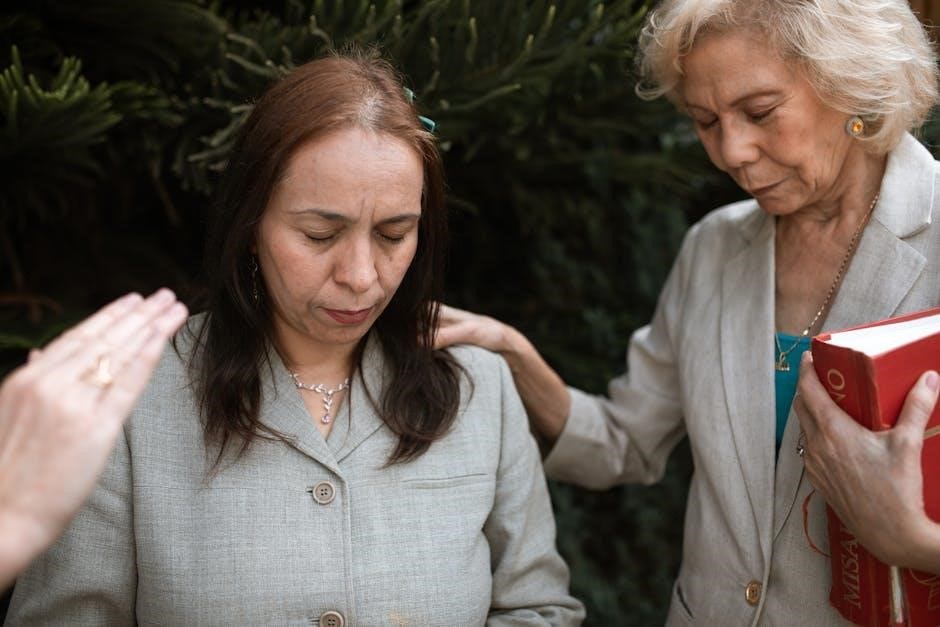
Using the Tabernacle as a Framework for Prayer
The Tabernacle serves as a powerful framework for prayer, guiding believers through its sacred spaces. Starting at the altar of sacrifice, prayers of repentance and surrender are offered, reflecting Christ’s atonement. Moving to the bronze laver, cleansing and purification are sought, symbolizing a heart made right before God. Entering the Holy Place, fellowship with God is deepened through communion, represented by the table of showbread. The golden lampstand illuminates God’s presence, while the altar of incense symbolizes rising prayers. Finally, the Most Holy Place invites reverence and awe, drawing believers into God’s throne room, emphasizing mercy and divine presence. This structured approach enriches prayer life, aligning it with biblical truths and fostering intimacy with God. By following this framework, prayers become more intentional, reflective, and transformative, mirroring the Tabernacle’s purpose as a dwelling place for God’s glory. This method not only honors the historical significance of the Tabernacle but also revitalizes modern prayer practices, ensuring a balanced and profound spiritual experience. Through this framework, believers can systematically address various aspects of their relationship with God, from surrender to intercession, ensuring a holistic and meaningful prayer life. Thus, the Tabernacle Prayer Guide offers a timeless model for connecting with God in a structured and deeply spiritual manner, making it a invaluable resource for believers seeking to deepen their prayer practice. The structured approach of the Tabernacle Prayer Guide ensures that each element of prayer is addressed, fostering a comprehensive and meaningful dialogue with God, much like the Israelites experienced in their worship. By integrating the Tabernacle’s symbolism into prayer, believers can create a more structured and intentional prayer life, drawing closer to God’s presence and will. This framework not only enhances personal devotion but also aligns individual and communal prayer with the rich biblical heritage of the Tabernacle, making it a powerful tool for spiritual growth and renewal. Ultimately, the Tabernacle Prayer Guide invites believers to embrace a prayer life that mirrors the sacred structure of the Tabernacle, leading to a more profound and transformative spiritual journey. By understanding and applying each element of the Tabernacle, prayers become more effective, heartfelt, and aligned with God’s divine plan, ensuring a deeper connection and fellowship with Him. This structured approach to prayer, inspired by the Tabernacle, offers believers a clear and meaningful way to engage with God, fostering a richer and more intimate prayer life that honors His presence and will; The Tabernacle Prayer Guide, therefore, stands as a timeless and practical resource for believers seeking to strengthen their prayer life through the sacred symbols and structure of the Tabernacle, ensuring a deeper and more meaningful connection with God. This framework not only enriches individual prayer but also serves as a unifying element for communal worship, reflecting the historical and spiritual significance of the Tabernacle in the life of God’s people. By following the Tabernacle as a framework for prayer, believers can experience a more balanced, intentional, and transformative prayer life, drawing from the rich biblical heritage of this sacred structure. The Tabernacle Prayer Guide thus provides a comprehensive and structured approach to prayer, enabling believers to engage deeply with God’s presence and will, fostering spiritual growth and renewal in their lives. In this way, the Tabernacle continues to serve as a powerful symbol and guide for effective and meaningful prayer, bridging the ancient and modern practices of worship. Through the Tabernacle Prayer Guide, believers can systematically explore the depths of prayer, ensuring that each aspect of their spiritual life is nurtured and strengthened, leading to a more vibrant and God-centered prayer practice. This structured framework, rooted in the Tabernacle’s design, offers believers a clear path to a deeper and more intimate relationship with God, enhancing their prayer life and spiritual journey. By embracing the Tabernacle as a framework for prayer, believers can experience the transformative power of intentional and structured prayer, drawing closer to God’s presence and will, much like the Israelites did in their sacred worship. The Tabernacle Prayer Guide, therefore, serves as an invaluable tool for modern believers, providing a structured and meaningful approach to prayer that honors the biblical heritage of the Tabernacle while fostering spiritual growth and renewal. Through this guide, prayer becomes not just a routine but a sacred journey through the Tabernacle’s elements, each step drawing believers closer to God’s heart and will, ensuring a prayer life that is both profound and transformative. The structured approach of the Tabernacle Prayer Guide ensures that each prayer session is comprehensive, addressing various aspects of the believer’s relationship with God, from repentance to intercession, and from cleansing to communion. This holistic approach to prayer, inspired by the Tabernacle, enriches the spiritual life of believers, making their prayers more effective and meaningful. By following the Tabernacle’s structure, believers can create a prayer life that is both intentional and structured, reflecting the sacredness and beauty of the Tabernacle, and drawing them into a deeper fellowship with God. The Tabernacle Prayer Guide thus offers a practical and inspiring model for prayer, helping believers to engage with God in a way that is both deeply personal and biblically grounded, ensuring a prayer life that is transformative and glorifying to God. Through the structured framework of the Tabernacle, believers can systematically explore the depths of prayer, addressing every aspect of their spiritual journey, from surrender to worship, and from intercession to communion. This comprehensive approach to prayer, inspired by the Tabernacle, ensures that believers experience a balanced and profound spiritual life, drawing them closer to God’s presence and will. The Tabernacle Prayer Guide, therefore, stands as a powerful resource for believers seeking to deepen their prayer life, providing a structured and meaningful framework that mirrors the sacred elements of the Tabernacle, and fostering a more intimate and transformative relationship with God. By embracing this guide, believers can move through the Tabernacle’s elements in their prayers, from the altar of sacrifice to the Most Holy Place, ensuring that each prayer is purposeful and aligned with God’s divine plan. This structured approach to prayer not only enriches individual devotion but also serves as a unifying element for communal worship, reflecting the historical and spiritual significance of the Tabernacle in the life of God’s people. Thus, the Tabernacle Prayer Guide offers a timeless and practical model for prayer, enabling believers to engage deeply with God’s presence and will, and fostering spiritual growth and renewal in their lives. Through the Tabernacle’s structure, believers can systematically explore the depths of prayer, ensuring that each aspect of their spiritual life is nurtured and strengthened, leading to a more vibrant and God-centered prayer practice. The Tabernacle Prayer Guide, therefore, serves as an invaluable tool for modern believers, providing a structured and meaningful approach to prayer that honors the biblical heritage of the Tabernacle while fostering spiritual growth and renewal. By following this guide, prayer becomes a sacred journey through the elements of the Tabernacle, drawing believers closer to God’s heart and will, ensuring a prayer life that is both profound and transformative. The structured approach of the Tabernacle Prayer Guide ensures that each prayer session is comprehensive, addressing various aspects of the believer’s relationship with God, from repentance to intercession, and from cleansing to communion. This holistic approach to prayer, inspired by the Tabernacle, enriches the spiritual life of believers, making their prayers more effective and meaningful. By following the Tabernacle’s structure, believers can create a prayer life that is both intentional and structured, reflecting the sacredness and beauty of the Tabernacle, and drawing them into a deeper fellowship with God. The Tabernacle Prayer Guide thus offers a practical and inspiring model for prayer, helping believers to engage with God in a way that is both deeply personal and biblically grounded, ensuring a prayer life that is transformative and glorifying to God. Through the structured framework of the Tabernacle, believers can systematically explore the depths of prayer, addressing every aspect of their spiritual journey, from surrender to worship, and from intercession to communion. This comprehensive approach to prayer, inspired by the Tabernacle, ensures that believers experience a balanced and profound spiritual life, drawing them closer to God’s presence and will. The Tabernacle Prayer Guide, therefore, stands as a powerful resource for believers seeking to deepen their prayer life, providing a structured and meaningful framework that mirrors the sacred elements of the Tabernacle, and fostering a more intimate and transformative relationship with God. By embracing this guide, believers can move through the Tabernacle’s elements in their prayers, from the altar of sacrifice to the Most Holy Place, ensuring that each prayer is purposeful and aligned with God’s divine plan. This structured approach to prayer not only enriches individual devotion but also serves as a unifying element for communal worship, reflecting the historical and spiritual significance of the Tabernacle in the life of God’s people. Thus, the Tabernacle Prayer Guide offers a timeless and practical model for prayer, enabling believers to engage deeply with God’s presence and will, and fostering spiritual growth and renewal in their lives. Through the Tabernacle’s structure, believers can systematically explore the depths of prayer, ensuring that each aspect of their spiritual life is nurtured and strengthened, leading to a more vibrant and God-centered prayer practice. The Tabernacle Prayer Guide, therefore, serves as an invaluable tool for modern believers, providing a structured and meaningful approach to prayer that honors the biblical heritage of the Tabernacle while fostering spiritual growth and renewal. By following this guide, prayer becomes a sacred journey through the elements of the Tabernacle, drawing believers closer to God’s heart and will, ensuring a prayer life that is both profound and transformative. The structured approach of the Tabernacle Prayer Guide ensures that each prayer session is comprehensive, addressing various aspects of the believer’s relationship with God, from repentance to intercession, and from cleansing to communion. This holistic approach to prayer
Maintaining Intimacy with God Through Daily Prayer

Maintaining intimacy with God through daily prayer is essential for a vibrant spiritual life. The Tabernacle Prayer Guide emphasizes the importance of consistent communication with God, mirroring the Israelites’ daily offerings and sacrifices. Just as the priests tended the altar and lampstand daily, believers are encouraged to dedicate time each day to prayer, ensuring a continuous connection with God’s presence. This daily practice fosters a deeper relationship, much like the ongoing worship in the Tabernacle. By prioritizing prayer, believers can experience the transformative power of God’s presence, drawing strength and guidance for their daily lives. This consistent engagement with God ensures that prayer becomes a steadfast and life-giving habit, nurturing intimacy and spiritual growth. Through the Tabernacle Prayer Guide, believers are reminded that daily prayer is not just a duty but a sacred privilege, enabling them to walk in the light of God’s presence continually. By integrating the Tabernacle’s teachings into daily prayer, believers can maintain a vibrant and intimate connection with God, reflecting the heart of worship and fellowship that the Tabernacle represents. This consistent prayer practice, inspired by the Tabernacle, ensures that believers remain rooted in God’s love and grace, experiencing His presence in every aspect of their lives. Thus, the Tabernacle Prayer Guide offers a practical and inspiring model for maintaining intimacy with God through daily prayer, fostering a deeper and more meaningful spiritual journey. By embracing this approach, believers can cultivate a prayer life that honors God’s desire for continuous fellowship, ensuring a strong and abiding relationship with Him. This daily commitment to prayer, guided by the Tabernacle’s symbolism, enriches the believer’s spiritual life, drawing them closer to God’s heart and will. Through consistent prayer, believers experience the transformative power of God’s presence, leading to a life marked by intimacy, joy, and spiritual fulfillment; The Tabernacle Prayer Guide, therefore, serves as a powerful reminder of the importance of daily prayer in maintaining intimacy with God, offering a structured and meaningful approach to deepening this sacred relationship. By prioritizing daily prayer, believers can walk in the light of God’s presence, experiencing His guidance and strength in their everyday lives, much like the Israelites experienced His presence in the Tabernacle. This consistent engagement with God ensures that prayer remains a vital and life-giving practice, nurturing intimacy and spiritual growth. Through the Tabernacle Prayer Guide, believers are encouraged to make daily prayer a cornerstone of their spiritual life, fostering a deeper connection with God and reflecting the heart of worship that the Tabernacle represents. By integrating the Tabernacle’s teachings into daily prayer, believers can maintain a vibrant and intimate relationship with God, experiencing His presence and grace in every moment. This structured approach to prayer, inspired by the Tabernacle, ensures that believers remain rooted in God’s love, drawing strength and guidance from His presence. Thus, the Tabernacle Prayer Guide offers a practical and inspiring model for maintaining intimacy with God through daily prayer, fostering a deeper and more meaningful spiritual journey. By embracing this approach, believers can cultivate a prayer life that honors God’s desire for continuous fellowship, ensuring a strong and abiding relationship with Him. This daily commitment to prayer, guided by the Tabernacle’s symbolism, enriches the believer’s spiritual life, drawing them closer to God’s heart and will. Through consistent prayer, believers experience the transformative power of God’s presence, leading to a life marked by intimacy, joy, and spiritual fulfillment. The Tabernacle Prayer Guide, therefore, serves as a powerful reminder of the importance of daily prayer in maintaining intimacy with God, offering a structured and meaningful approach to deepening this sacred relationship. By prioritizing daily prayer, believers can walk in the light of God’s presence, experiencing His guidance and strength in their everyday lives, much like the Israelites experienced His presence in the Tabernacle. This consistent engagement with God ensures that prayer remains a vital and life-giving practice, nurturing intimacy and spiritual growth. Through the Tabernacle Prayer Guide, believers are encouraged to make daily prayer a cornerstone of their spiritual life, fostering a deeper connection with God and reflecting the heart of worship that the Tabernacle represents. By integrating the Tabernacle’s teachings into daily prayer, believers can maintain a vibrant and intimate relationship with God, experiencing His presence and grace in every moment. This structured approach to prayer, inspired by the Tabernacle, ensures that believers remain rooted in God’s love, drawing strength and guidance from His presence. Thus, the Tabernacle Prayer Guide offers a practical and inspiring model for maintaining intimacy with God through daily prayer, fostering a deeper and more meaningful spiritual journey. By embracing this approach, believers can cultivate a prayer life that honors God’s desire for continuous fellowship, ensuring a strong and abiding relationship with Him. This daily commitment to prayer, guided by the Tabernacle’s symbolism, enriches the believer’s spiritual life, drawing them closer to God’s heart and will. Through consistent prayer, believers experience the transformative power of God’s presence, leading to a life marked by intimacy, joy, and spiritual fulfillment. The Tabernacle Prayer Guide, therefore, serves as a powerful reminder of the importance of daily prayer in maintaining intimacy with God, offering a structured and meaningful approach to deepening this sacred relationship. By prioritizing daily prayer, believers can walk in the light of God’s presence, experiencing His guidance and strength in their everyday lives, much like the Israelites experienced His presence in the Tabernacle. This consistent engagement with God ensures that prayer remains a vital and life-giving practice, nurturing intimacy and spiritual growth. Through the Tabernacle Prayer Guide, believers are encouraged to make daily prayer a cornerstone of their spiritual life, fostering a deeper connection with God and reflecting the heart of worship that the Tabernacle represents. By integrating the Tabernacle’s teachings into daily prayer, believers can maintain a vibrant and intimate relationship with God, experiencing His presence and grace in every moment. This structured approach to prayer, inspired by the Tabernacle, ensures that believers remain rooted in God’s love, drawing strength and guidance from His presence. Thus, the Tabernacle Prayer Guide offers a practical and inspiring model for maintaining intimacy with God through daily prayer, fostering a deeper and more meaningful spiritual journey. By embracing this approach, believers can cultivate a prayer life that honors God’s desire for continuous fellowship, ensuring a strong and abiding relationship with Him. This daily commitment to prayer, guided by the Tabernacle’s symbolism, enriches the believer’s spiritual life, drawing them closer to God’s heart and will. Through consistent prayer, believers experience the transformative power of God’s presence, leading to a life marked by intimacy, joy, and spiritual fulfillment. The Tabernacle Prayer Guide, therefore, serves as a powerful reminder of the importance of daily prayer in maintaining intimacy with God, offering a structured and meaningful approach to deepening this sacred relationship. By prioritizing daily prayer, believers can walk in the light of God’s presence, experiencing His guidance and strength in their everyday lives, much like the Israelites experienced His presence in the Tabernacle. This consistent engagement with God ensures that prayer remains a vital and life-giving practice, nurturing intimacy and spiritual growth. Through the Tabernacle Prayer Guide, believers are encouraged to make daily prayer a cornerstone of their spiritual life, fostering a deeper connection with God and reflecting the heart of worship that the Tabernacle represents. By integrating the Tabernacle’s teachings into daily prayer, believers can maintain a vibrant and intimate relationship with God, experiencing His presence and grace in every moment. This structured approach to prayer, inspired by the Tabernacle, ensures that believers remain rooted in God’s love, drawing strength and guidance from His presence. Thus, the Tabernacle Prayer Guide offers a practical and inspiring model for maintaining intimacy with God through daily prayer, fostering a deeper and more meaningful spiritual journey. By embracing this approach, believers can cultivate a prayer life that honors God’s desire for continuous fellowship, ensuring a strong and abiding relationship with Him. This daily commitment to prayer, guided by the Tabernacle’s symbolism, enriches the believer’s spiritual life, drawing them closer to God’s heart and will. Through consistent prayer, believers experience the transformative power of God’s presence, leading to a life marked by intimacy, joy, and spiritual fulfillment. The Tabernacle Prayer Guide, therefore, serves as a powerful reminder of the importance of daily prayer in maintaining intimacy with God, offering a structured and meaningful approach to deepening this sacred relationship. By prioritizing daily prayer, believers can walk in the light of God’s presence, experiencing His guidance and strength in their everyday lives, much like the Israelites experienced His presence in the Tabernacle. This consistent engagement with God ensures that prayer remains a vital and life-giving practice, nurturing intimacy and spiritual growth. Through the Tabernacle Prayer Guide, believers are encouraged to make daily prayer a cornerstone of their spiritual life, fostering a deeper connection with God and reflecting the heart of worship that the Tabernacle represents. By integrating the Tabernacle’s teachings into daily prayer, believers can maintain a vibrant and intimate relationship with God, experiencing His presence and grace in every moment. This structured approach to prayer, inspired by the Tabernacle, ensures that believers remain rooted in God’s love, drawing strength and guidance from His presence. Thus, the Tabernacle Prayer Guide offers a practical and inspiring model for maintaining intimacy with God through daily prayer, fostering a deeper and more meaningful spiritual journey. By embracing this approach, believers can cultivate a prayer life that honors God’s desire for continuous fellowship, ensuring a strong and abiding relationship with Him. This daily commitment to prayer, guided by the Tabernacle’s symbolism, enriches the believer’s spiritual life, drawing them closer to God’s heart and will. Through consistent prayer, believers experience the transformative power of God’s presence, leading to a life marked by intimacy, joy, and spiritual fulfillment. The Tabern

